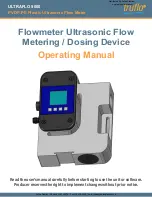
720A Operation and Maintenance Manual – Rev S – January 25, 2019
Page 12
13231 Rooster Springs Rd.,
Austin, TX 78737
T:
(512) 858-4045
E:
amptec.com
D-2.4 Banana Jack Terminals
These gold-plated banana jack terminals (refer to item 4 within
Figure 1
on page 9)
enable the end user to make 4-wire measurements by acting as connectors for
cable/lead/probe sets. They are compatible with any 4-wire cable, lead, or probe set
that has banana jacks. Simply connect your cable set by inserting your black cable(s)
into the VLO terminals, and your red cable(s) into the VHI terminals. You may also
connect bare wires to these terminals by unscrewing the plastic caps, which then
exposes gold posts that the wires can be attached to. For more information on test lead
connections to these terminals and how to use test leads to make measurements, refer
to section D-5.
D-2.5 Autorange Button and Function Information
This button (refer to item 5 within
Figure 2
on page 10) is only present in the NSN
version of the 720A meter. Pressing this button enables the unit to automatically select
its range of measurement, thus activating the unit’s autorange mode. To use this
button/feature, first ensure that all other range buttons are fully extended (deselected)
and press the AUTO button. If you would like to disable this feature and manually select
your range of measurement, you may simply press the appropriate range switch and the
autorange feature will turn off. The autorange function will automatically select the
correct resistance range, given that the reading is between 0
Ω
and 200 K
Ω
. If the
reading is above 200 K
Ω
, the meter will enter overrange mode until a lower reading is
applied or the autorange is turned off/deselected. For more information on overrange
mode, see section D-2.3.2 on the previous page.
D-2.6 Unit of Measurement LEDs
This feature (refer to item 6 within
Figure 2
on page 10)
is only present in the NSN
version of the 720A meter. These three LEDs indicate which unit of measurement is
being displayed (either mΩ, Ω, or KΩ) when using the unit. Only one LED should be lit
per measurement. No action is required by the end user to enable this feature – these
LEDs should engage automatically when the unit is turned on.













































